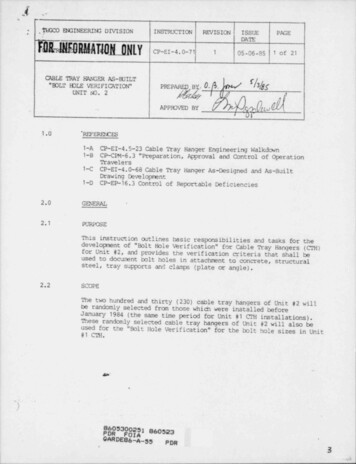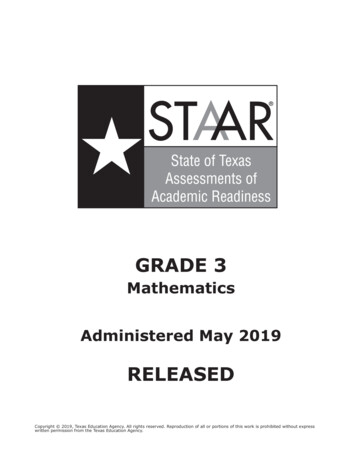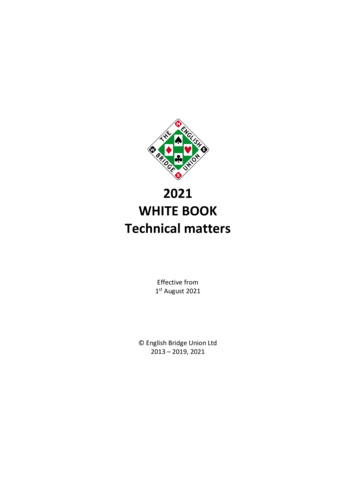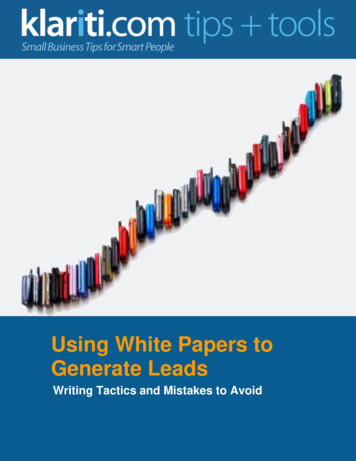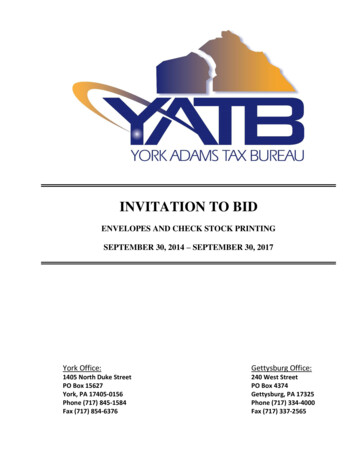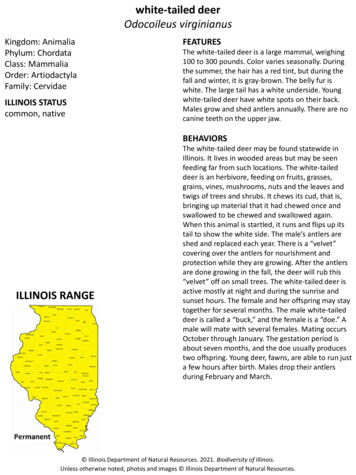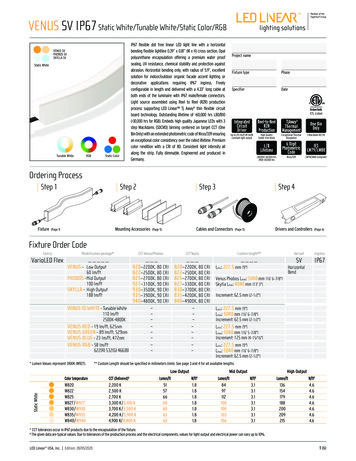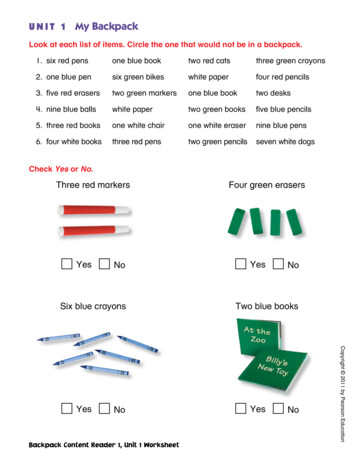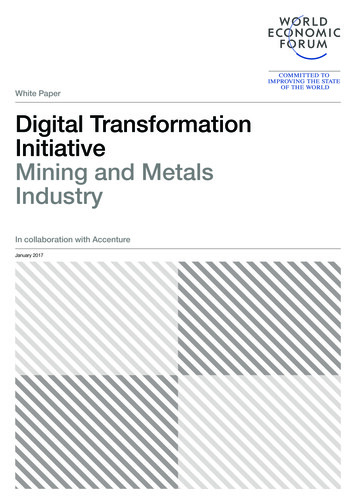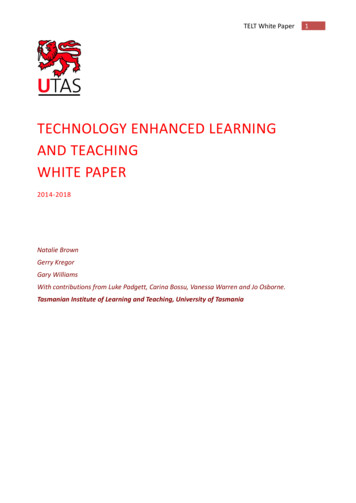
Transcription
TELT White PaperTECHNOLOGY ENHANCED LEARNINGAND TEACHINGWHITE PAPER2014-2018Natalie BrownGerry KregorGary WilliamsWith contributions from Luke Padgett, Carina Bossu, Vanessa Warren and Jo Osborne.Tasmanian Institute of Learning and Teaching, University of Tasmania1
TELT White Paper2TABLE OF CONTENTSOur Vision . 3Introduction and Scope . 4Chapter 1: Our Purposes and Values . 6Chapter 2: The UTAS Learning Environment . 8Chapter 3: Opening UTAS to the World . 23Chapter 4: Strategy, governance and policy implications . 32Chapter 5: Summary of Principles and Enablers . 38References . 43Appendix 1.Consultation and Contributors . 45Appendix 2.Terminology and definitions . 48Appendix 3.MyLO Levels 0 to 5 . 61Appendix 4.Impact of OER options . 63
TELT White Paper3Our VisionUTAS will be a leader in blended learning. Our brand of blended learning will feature: high quality unit and course resources made available to students online, including thoseauthored by students and open educational resources, and administrative and studentsupport resources;opportunities for synchronous and asynchronous interactions - peer to peer, student toteacher and teacher to student; andhigh impact learning, teaching and assessment experiences delivered on campus, situatedin a context such as field work or a practicum, or fully online.Forging a direction in learning that puts students firmly at the centre, the blended learning vision: provides UTAS students with a contemporary learning experience that reflects theirexpectations and the 21st century skills expected of graduates; enables students, regardless of location, time and mode of study to:o access core information about their units and courses;o communicate with their teachers and peers;o access high quality learning resources; ando monitor and receive feedback on their progress. recognises that UTAS is highly regarded for its interactive teaching, and builds on this toencourage interaction in both synchronous and asynchronous modes; places significant emphasis on academic choice with respect to how and where the highimpact learning and assessment experiences will take place, encouraging these experiences tobe tailored to achievement of the learning outcomes of the unit and course; encourages recognition of the expertise of UTAS teachers through sharing developedresources with the broader academic community; and encourages and affirms the use of high quality content sourced from experts in Tasmania andaround the globe, through open educational resources and collaborative opportunities notbounded by place.
TELT White Paper4Introduction and ScopeTechnology is ubiquitous in today’s world and in a modern university. At UTAS technology crossesthe remit of learning and teaching, research, library services, student support, studentadministration, marketing, human resources, finance, planning and corporate services. The focusof this white paper is learning and teaching.The vision articulated in the Strategic Plan for Learning and Teaching, 2012-2014 (UTAS, 2012)compels us to embrace technology to enhance student learning. Technology can also help us meetother aspects of this vision - to capitalise on collaborative opportunities, increase participation andretention in higher education, to prepare our graduates for the twenty-first century and reach outas a global educator.UTAS will unlock potential and transform the lives of individuals and the communities in whichthey live. We will ensure that UTAS graduates will be equipped and inspired to shape andrespond to the opportunities and challenges of the twenty-first century. Through the acquisitionof subject and multidisciplinary knowledge and skills our graduates will be able to participate associally responsible citizens in local, national and global society.We see excellence in the student experience and of student learning as the overall goals thatframe our approaches to Learning and Teaching. UTAS will ensure therefore that teaching andthe learning environment are of the highest quality and are enriched by world class research andthe fruits of our global and local partnerships. Our approaches will be innovative and usetechnology that enhances learning and teaching. Excellence will be recognised, rewarded andcelebrated.UTAS will increase participation and attainment in tertiary education. UTAS embraces its role as aglobal educator and its unique responsibility in raising the educational attainment levels ofTasmanians.Strategic Plan for Learning and Teaching, 2012-2014, (UTAS, 2012)At UTAS we use technology in learning and teaching for eight key purposes. To: improve the quality of the learning environment and student learning outcomes;access the best quality resources from around the world;connect students to each other, their teachers and to the world;prepare students to thrive in a technology rich environment;improve access to, and flexibility of, university study for students;build UTAS reputation and brand in a global education market;increase student enrolments through targeting new groups of students; andmeet the service expectations of students, staff and stakeholders.Technology enhanced learning and teaching (TELT) has been part of the higher education
TELT White Paper5landscape for at least 30 years. During this time technologies and pedagogical practice haveevolved and matured and the conditions for the delivery of high quality learning and a satisfyingstudent experience are well characterised. Consequently, there is much to be learnt from recentsector-wide national and international studies focussed on technology enhanced learning andteaching. The key findings of these studies, referenced in this white paper, are included inBackground Paper 1Given the student-focussed nature of this white paper, it is fitting to refer to a specific study at theoutset. The ECAR Study of Undergraduate Students and Information Technology (Dahlstrom, 2012)outlines the results of surveys administered to over 100,000 students at 195 institutions fromaround the world. A key finding was that ‘Blending modalities and engaging learners is a winningcombination’ (p.7). The survey concluded that blended learning environments are the norm interms of delivery and that students say that blended learning best supports how they learn.Furthermore, ‘Students believe that technology is critical to academic success and that it plays animportant part in their future accomplishments’ (p 19) and ‘Students want multiplecommunication options, and they prefer different modes for different purposes and audiences’(p.25).This white paper sets out a five-year vision for UTAS in technology enhanced learning and teaching.Chapter 1 considers the UTAS context and the values of the institution. Chapter 2 describes theoptimal student learning environment. Chapter 3 examines the notion that UTAS can usetechnology to extend its influence and contributions nationally and internationally through openeducational practices. The interplay between the vision, technology and governance is explored inChapter 4, and the enablers necessary to achieve it, in concert with the principles, are thenrevisited in Chapter 5. In addition to considering the current literature, the white paper has beeninformed by a series of consultations across UTAS with major stakeholders (Appendix 1). Appendix2 contains a glossary of terminology used in this white paper.The blended learning vision at the heart of this paper capitalises on what we already do well atUTAS. It recognises the diversity of learning styles and expectations of current students and theirneed to balance their study commitments with work, family and social life. It seeks to embrace thepotential of technology to support and enhance the work of university teachers. It confronts andresponds to the external environment with which we interact: The increasing move to openness inthe higher education sector, with high quality content increasingly available for adaptation andreuse, and the affordances of new technologies providing mobile learning, personalisation oflearning platforms and opportunities for real time data and analytics to support student learning.
TELT White Paper6Chapter 1. Our Purposes and ValuesUTAS aspires to position itself as a lead university in an increasingly competitive global market.Technology is an essential enabler to realise this aspiration. The Vice Chancellor has outlined theneed for UTAS to ‘embrace technology as a key component of the learning experience, and todeliver curriculum with the flexibility required by students who may be restricted by geography orthe demands of our work’ (Rathjen, 2011, p.6). Adoption of the blended learning model willassist us in achieving this vision. The model reflects the purposes and values of UTAS. Therefore, inadopting this vision for technology enhanced learning and teaching we note and affirm UTASvalues.At UTAS we recognise that the potential of technology enhanced learning is not only for thebenefit of local and national students who require flexibility in study or who have difficultiesaccessing on-campus education, but also in reaching out to a global audience. In 2010 UTASinvested in a new core component of the learning management system (LMS). The Desire2Learn(D2L) suite offers a powerful platform for onlinelearning. Implementation of the system has includedRecognising that from relationshipsco-construction, with the vendor, of a platform thatflow opportunity, we must configureprovides a high quality learning experience andourselves to facilitate meaningfulintegrates applications such as web conferencing,partnershipswithgovernment,which facilities vibrant real-time interactions, andindustry and communities in TasmaniaePortfolios, that facilitate students and staffand across the world. (Open to Talent,responding to the graduate employability and2012, P.9)external stakeholder agendas. The affordances of theLMS, called MyLO (My Learning Online), enhance the learning experience of students studyingboth on and off campus.UTAS recognises the evolving democratisation of education through the availability of onlinelearning resources. The provision of a second, openly accessible instance of the D2L platformprovides UTAS with the opportunity to take its areas of expertise to the world. Opening up ourresources in areas of expertise will also provide opportunities to forge partnerships with otheruniversities, and with governments, industries and communities. Sharing our expertise can notonly build reputation and brand, it can also help us to respond to areas of social need.With a wider uptake of technology enhanced learning, new possibilities arise for the use of onlineassessment and analytics to inform students and staff about the progress of learning, and guideenhancements to the learning process. The learning analytics functions afforded by the D2Llearning suite are beginning to be explored. Together with academic analytics, learning analyticscan empower greater responsiveness to students’ needs and proactive approaches to achievinghigh quality student learning outcomes.Adoption of technologies can assist us nurture a vital and sustainable community, throughfacilitating interactions that go beyond what is possible when bounded by time and location.
TELT White Paper7Inclusion of students who may otherwise be unable to attend university can be afforded throughflexible offerings and assistive technologies allowing us to work from the strength that diversitybrings. Coupled with the quality interactions that are a vital component of our blended model,the opportunity for sharing of studentauthored resources, and resources sourcedfrom high quality open repositories, we areable to design learning experiences that drawon diverse perspectives.Our blended learning units, with their highquality resources and encouragement ofsustained interaction, will be testimony to ourcommitment to create and serve a sharedpurpose. This value will perhaps best beillustrated by our sharing of resources with abroader community to serve the common good. The creation of a culture of blended learning willenable sharing of UTAS research and education expertise beyond our own enrolled students. Ourblended learning design will enable the incorporation of open educational practices and open thedoor for short courses and public outreach.Creating a technologically rich and connected environment where students engage with eachother, and the global community, on contemporary issues and innovative practices will allow us tocollaborate to be the best we can be. This environment will go beyond the virtual learningenvironment of the LMS and extend to on-campus spaces that enable students to engage witheach other and with online resources, and enable teachers to use technology to enhance oncampus experiences.
TELT White PaperChapter 2. TheUTAS8LearningEnvironmentPRINCIPLE 1: THE UTAS LEARNING ENVIRONMENT WILL USE TECHNOLOGY TO ENRICH THESTUDENT LEARNING EXPERIENCE THROUGH THE PROVISION OF QUALITY RESOURCES;RICH PEER-PEER, STUDENT-TEACHER, AND TEACHER-STUDENT INTERACTIONS; ANDENGAGING, HIGH IMPACT LEARNING EXPERIENCESThe ECAR report (Dahlstrom, 2012) concludes that blended learning environments are now thenorm, with students identifying that these environments best support how they learn.Furthermore, the report states that: ‘Students expect their instructors to use technology to engagethem in the learning process, and instructors are responding’ (p.9). Given the scope of this study,and the coherence of these findings with surveys of UTAS students (Kregor, Breslin, & Fountain,2012), the argument for adoption of a blended approach is compelling.Recent Australian reports (e.g. James, Krause, & Jennings, 2010) on the study-work balance ofuniversity students have outlined that, on average, students have 13 hours of paid work each weekand are spending less time on-campus. Coupled with the family responsibilities of many students,it is well documented that students need flexible and convenient access to learning resources.Furthermore, with the increasing affordability and ownership of mobile devices such as tablet PCsand iPad-type devices students are expecting that these resources are accessible not onlyanywhere and anytime, but also from a range of devices.Online provision of unit resources poses some dilemmas to academic staff and administrators.Will the provision of unit resources result in students not attending face to face classes? Willstudent experience and student learning be compromised? To address this, a distinction needs tobe made between online resources and online education. Units delivered online have been provento be highly successful in achieving quality student outcomes, however these units arepurposefully designed to provide learning experiences for students. They are not simply acollection of online resources. Extending this argument, provision of reources online, inclusive of aseries of recorded lectures, does not constitute an online unit. In addition to the resources, twoother elements must be present – opportunities for interaction and high impact learningexperiences. These high impact learning experiences are purposefully designed to help studentsachieve the learning outcomes of the unit. It is most likely that their experiences will be differentdepending upon the mode of study – on-campus, situated in a context (e.g. workplace, fieldsetting), or fully online.In the UTAS blended learning model, the distinction in the type of delivery will be made accordingto where the purposefully designed high impact learning experiences take place. These may be oncampus, situated or fully online, acknowledging that some units will utilise more than one of thesemodes.
TELT White Paper9Element 1All UTAS students, regardless of location or mode of study, will have: access to core unit and course information;access to the same suite of high quality learning resources;access to online library resources; andaccess to excellent student support services.Administrative informationThe online environment offers many advantages to both students and staff in the provision ofresources to support learning. In the first instance, provision of the unit outline and timetableinformation can be automated or streamlined through the LMS (MyLO). This has a number ofadvantages for all stakeholders. Basic unit and course information can be delivered in an efficientmanner, and be drawn from a single source that represents the most up to date version of relevantdocuments. This should include drawing unit information directly from the Course and UnitDatabase and automated uploading of unit outlines from a content management system thatfacilitated real time updates of information. Use of MyLO to provide mandated generalinformation, such as academic integrity and plagiarism rules and guidelines, workplace health andsafety procedures, and appeals procedures can save overcrowding unit outlines, whilststreamlining version control.The use of MyLO in blended learning units opens new opportunities that suggest better ways ofworking. The current unit outline is a product of past models of delivery. Whilst it has beenadapted to encompass some aspects of blended learning approaches, its reification into a staticdocument militates against meaningful representation of the unit of study to students. Forexample the two sections on “Use of MyLO in this unit” and “Details of teaching arrangements”are separate – however the use of MyLO is a very important part of the teaching arrangements forany unit and it is important that this is conveyed to students so that they understand how tonavigate the blend of face-to-face and online components. There are numerous other
TELT White Paper10affordances inherent in the LMS that suggest that deconstructing the unit outline and placing theinformation in contexts in the LMS may be more meaningful and better describe the requiredactivity in a unit.Resources to support learningAdding to the online resources that help students achieve the unit learning outcomes has anumber of advantages. For students, it allows them to engage with content and learning activitiesat a time and place that suits them. It also allows them to revisit these throughout the unit – bothindividually and with their class peers. For staff, it potentially frees up preparation and deliverytime, and allows for innovations in teaching practices. Resources, once developed, can often bereused with minimal input in successive offerings of a unit. It is also possible, and oftenappropriate, to reuse or adapt open educational resources developed by other experts in the field.This creates efficiencies by removing the need to develop resources that may already exist. Theeducational resources may be sourced from those authored by UTAS colleagues, or colleaguesfrom other universities throughout the world, as well as other quality online repositories.Providing high quality online resources has significant potential to facilitate teaching innovations.In on-campus units, up front delivery of some content can be used to ‘flip’ the classroom, soteaching time is spent on higher order activities such as applying, analysing, evaluating andcreating from the content. Online provision of resources and learning activities also facilitates arethinking of the traditional timetabling of units. For example, it may be more appropriate forachieving the learning outcomes in some units that attendance occur in full or half day blocks,spread over the semester.Providing learning resources online can be used to ensure that on-campus activities can befocussed and the time well used. In Science and Medicine, some UTAS teachers provide onlinelaboratory preparation activities to reduce the cognitive load on students when they attend thelaboratory. Class time is then used more productively, and questions from students are morefocussed on the learning outcomes of the laboratory class, rather than lower order proceduralquestions. At UTAS, Zoology (Jones & Edwards, 2010) and Medicine (Choi-Lundberg, Cuellar, &Williams, 2012; Williams, Cuellar, & Choi-Lundberg, D.L. 2012) are currently using such approaches.Academics in the School of Human Life Sciences have also developed high quality resources thatassist students to sustain and extend their learning by successfully recalling and transferring unitcontent into new learning domains. These online game-based resources provide an active, funand positive learning experience. Students’ results, and feedback from students, indicate that theresources effectively target a mixed cohort of students to retain, link and extend foundationknowledge (Douglas, Slater, & Capstick, 2011).In moving to a blended model it is recognised that this will represent additional work, in the firstinstance, for some teachers. However, it is argued that in the longer term there will be significantefficiencies through building coherent unit presences including unit and course resources in MyLO.Complementary learning resourcesA key provider of an extensive range of electronic resources to support learning and teaching, and
TELT White Paper11research at UTAS is the Library. By enabling direct access to Library eResources through MyLO weprovide students with a consistent, integrated learning experience in which access to scholarlymaterial and help resources is contextual, straightforward and instantaneous. In addition, makinguse of the Library’s eResources, such as electronic reading lists, means that teachers are freed fromhaving to spend time on administrative tasks such as file and link management and copyrightchecking. Students also have ready access to referencing self-help, discipline specific resourceguides and AskUs FAQ, for quick answers to common questions.MyLO is also an important conduit for other student learning support. The continuingdevelopment of online resources by the Student Centre can also be capitalised on with theblended model. Easy linkage to online resources provides just in time access to assistance andopportunities for students to make appointments (e.g. http://www.utas.edu.au/studentlearning/online).One largely untapped efficiency is to reuse and adapt open educational resources that have beenauthored elsewhere. These may be from UTAS colleagues or from the learning object repositories(LORs) of other higher education institutions or similar organisations. In order to capitalise onthis efficiency time needs to be allocated for the sourcing of materials and professional learningaround copyright and licensing issues.The provision of quality resources to all students regardless of mode can potentially free up somepreparation time of staff teaching in both on-campus and distance mode. However, although thesame high quality resources can be supplied to both student cohorts, quality online delivery is notachieved through replicating the on-campus experience online. Time saved in preparing one set ofresources can thus be directed towards design, delivery and refinement of the high impactlearning experiences that best suits the mode of study of each cohort.Element 2All UTAS students, regardless of location or mode of study, will have opportunities to interactwith their teachers and their peers in both synchronous and asynchronous modes.
TELT White Paper12There is clear evidence that academic success is underpinned by interaction with teachers and peers.Consultations for the white paper have affirmed that the UTAS learning environment ischaracterised by high quality student-student, student-teacher and teacher-student interactions.These quality interactions should be a feature of any UTAS unit, whether on-campus, situated orfully online.Technology is an important vehicle for interaction. In units that are taught fully online, or in asituated context, technology is vital for the facilitation of interaction. This can be synchronous andface to face utilising applications such as web conferencing; synchronous through chat or VoiceOver Internet Protocol (VOIP); or asynchronous through applications such as blogs, wikis,discussion boards, or through social media environments, such as Twitter, Facebook andInstagram. A key finding of the ECAR study (Dahlstrom, 2012) is that students recognise the LMS asthe key communication hub and for online purposes prefer direct interaction (teacher-student,student-student and student-teacher) via the LMS or by email connected to the LMS.In EAL211 Facilitating Engaging Learning Experiences, in the Bachelor of Education (AppliedLearning), the challenge was to model effective facilitation skills, encourage studentengagement in a variety of learning experiences, and ensure theory and practice wereconnected, all within a fully online unit. Consistent with a desire to have applied, authenticstrategies (both for learning and assessment), students were involved in many collaborativeactivities, including: choosing a topic and facilitating an online discussion, creating andsharing a YouTube video of their ‘tips and tricks’ for facilitating groups, regular webconferences (often with an guest expert) to engage in collegial discussions, and recordedinterviews between the lecturer and professional facilitators working in Asia, Europe and theUnited States. This was underpinned by relevant readings, recorded presentations onparticular topics, weekly discussions in MyLO, and Skype calls to individual students.Assessment tasks included conducting facilitation sessions in their own context and reportingon those activities The eVALUate Unit report reflected a 100% satisfaction result fromstudents, with many of the students noting their appreciation of a wide range of resourcesand teaching strategies, and the high level of teacher ‘presence’ in the unit.Jill Downing, Faculty of EducationIn units where the high impact learning experiences (HILEs) are on-campus, these methods ofcommunication may be equally applicable. Working with peers to consolidate learning, to revisitcontent, to collaborate on assessment tasks or to ask questions of peers or teachers, or othersubject experts can be carried out using a similar range of technologies. What is important forstudents studying in an on-campus mode is that they have the opportunity and the learning spacesto allow them to meet, review and analyse online materials, and collaborate on projects andinquiries.
TELT White Paper13It is important that interaction is not seen as being confined to a particular unit or cohort.Technology can facilitate collaboration and communication between many different groups.Immersive communication technologies allow on and off campus units to join together in a singleevent – whilst this might be a lecture, itequally may be a debate, expert paneldiscussion, role play exercise orsimulation. Having spaces on-campusthat facilitate these types of interactivelearning experiences is highly desirableand increasingly commonplace inuniversities.In addition to interaction betweenstudents within a unit, interactionbetween prospective students, currentstudents and graduates should also beexplored. In the same vein, interaction with stakeholders outside UTAS needs to be achievablewhere it contributes to learning outcomes. This requires communication systems that allowconnections outside UTAS accounts, and for instances where UTAS students are not able to log into UTAS systems, such as when students are on work placements or overseas. The potential ofonline communication to support work integrated learning (WIL) is exciting and offers ways tobetter support students when they are on placements or internships through providing interactionopportunities with their supervisors and peers.
TELT White Paper14Element 3All UTAS students, regardless of location or mode of study, will have purposefully designedhigh impact learning experiences that enable them to achieve the learning outcomes of theunit and course.The concept of high impact learning experiences (HILEs) is based on the work of George Kuh (2008)who looked at high impact educational practices in higher education. Through extensive researchand data gained from national student surveys (in particular the National Study of StudentEngagement in the US, adopted in Australia as the AUSSE), Kuh has outlined practices thatencourage active learning and student engagement increase rates of student retentio
Technology is ubiquitous in today's world and in a modern university. At UTAS technology crosses the remit of learning and teaching, research, library services, student support, student administration, marketing, human resources, finance, planning and corporate services. The focus of this white paper is learning and teaching.

